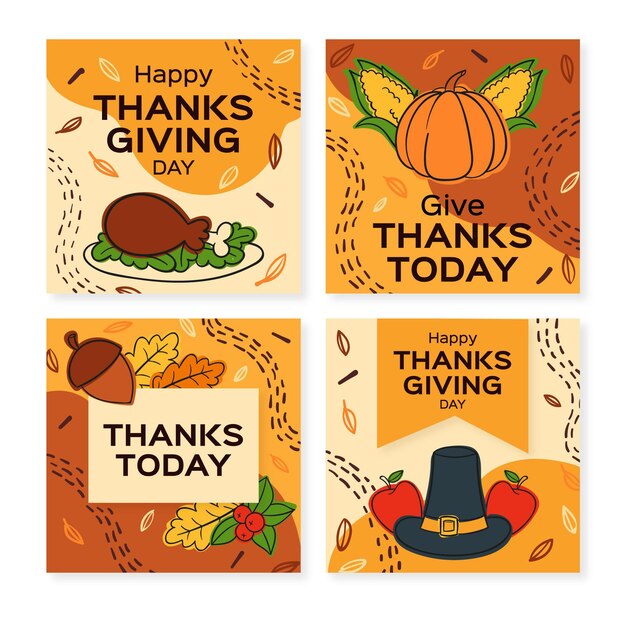Interesting Facts about Thanksgiving History

The first Thanksgiving celebration in America took place in 1621 and lasted for three days.
The Pilgrims, who celebrated the first Thanksgiving, were a group of English settlers seeking religious freedom.
The exact date of the first Thanksgiving is uncertain, but it likely occurred in late September or early October.
Thanksgiving was not declared a national holiday in the United States until 1863 by President Abraham Lincoln.
The traditional Thanksgiving meal includes turkey, mashed potatoes, stuffing, cranberry sauce, and pumpkin pie.
The Macy’s Thanksgiving Day Parade, a famous annual event in New York City, began in 19
7. The average number of calories consumed by an individual during a Thanksgiving meal is estimated to be around 4,500.
Turkey pardoning became a tradition in 1947 when President Harry Truman received a live turkey and decided to spare its life.
The heaviest turkey ever recorded weighed 86 pounds, according to the Guinness World Records.
The National Turkey Federation estimates that around 46 million turkeys are consumed in the United States on Thanksgiving.
The term cornucopia, which refers to a horn-shaped basket filled with fruits and vegetables, originates from Greek mythology and is often associated with Thanksgiving.
The Plymouth Colony, where the first Thanksgiving occurred, had its own set of laws called the Plymouth Code of Laws.
The beloved Thanksgiving tradition of American football began in 1876 when Yale and Princeton played their first match on Thanksgiving Day.
Interesting Facts about Thanksgiving History part 2
The day after Thanksgiving, known as Black Friday, is considered the biggest shopping day of the year in the United States.
President Franklin D. Roosevelt tried to change the date of Thanksgiving in 1939 to boost holiday shopping, but it caused confusion and was later reverted.
The turkey became a symbol of Thanksgiving due to its abundance and affordability during the colonial times.
The first Thanksgiving celebration in Canada is believed to have taken place in 1578, predating the American celebration by over 40 years.
Benjamin Franklin, one of America’s founding fathers, wanted the turkey to be the national bird instead of the bald eagle.
The Plymouth Colony, where the Pilgrims settled, was named after the port city of Plymouth in England.
Sarah Josepha Hale, known as the Mother of Thanksgiving, campaigned for many years to make Thanksgiving a national holiday.
The Mayflower, the ship that brought the Pilgrims to America, was only about 106 feet long and 25 feet wide.
Pumpkin pie, a staple of the Thanksgiving dessert, dates back to the early colonial times when colonists used to fill pumpkins with milk, honey, and spices then roasted them over a fire.
Thanksgiving was initially celebrated as a harvest festival and a way to give thanks for a successful year of crops.
The pilgrims did not have forks during the first Thanksgiving and instead used spoons, knives, and their fingers.
The record for the longest distance traveled for Thanksgiving dinner is reportedly 5,000 miles, from Antarctica to New Zealand.
Thanksgiving became a federal holiday to be celebrated on the fourth Thursday of November in the United States.
Squanto, a Native American of the Patuxet tribe, played a vital role in helping the Pilgrims survive their first winter and taught them crucial skills, such as planting corn.
The word thanksgiving originated from the Old English term thancgiving, meaning the giving of thanks or gratitude.
The average number of guests at a Thanksgiving meal in the United States is
In 1941, Thanksgiving was officially declared to be celebrated on the fourth Thursday of November, regardless of the date.
Many Thanksgiving feasts feature a dish called green bean casserole, which was invented by the Campbell Soup Company in 1955.
The largest pumpkin pie ever made weighed over 2,000 pounds and had a diameter of over 12 feet.
While the Pilgrims and Native Americans likely ate turkey during the first Thanksgiving, other popular meats included ducks, geese, and deer.
In Canada, Thanksgiving is celebrated on the second Monday in October, while in the United States, it is celebrated on the fourth Thursday in November.
The first TV dinner, consisting of turkey, peas, and sweet potatoes, was introduced by Swanson in 1953 as a way to use up the excess turkey they had after Thanksgiving.
The phrase talking turkey is believed to originate from a tradition of Thanksgiving conversations during which people would discuss serious and important matters.
Thanksgiving was not celebrated as a recurring holiday in America until George Washington’s presidency.
During Thanksgiving, the President of the United States traditionally pardons a turkey, sparing it from being eaten.
President Franklin D. Roosevelt once moved Thanksgiving up by a week to extend the holiday shopping season during the Great Depression.
Thanksgiving has inspired famous works of art, including Norman Rockwell’s iconic Freedom from Want painting.
The cornucopia is often depicted with an abundance of fruits and vegetables, symbolizing the bountiful harvest traditionally associated with Thanksgiving.
The National Thanksgiving Turkey Presentation has been an annual event at the White House since 1989.
Pecan pie, a popular Thanksgiving dessert, originated in the southern United States and is made with pecans, corn syrup, and a flaky crust.
Thanksgiving was almost canceled during the American Revolution and the Civil War due to the turmoil and uncertainty of those times.
The Thanksgiving holiday season officially kicks off with the Macy’s Thanksgiving Day Parade and ends with the New Year’s celebrations.

